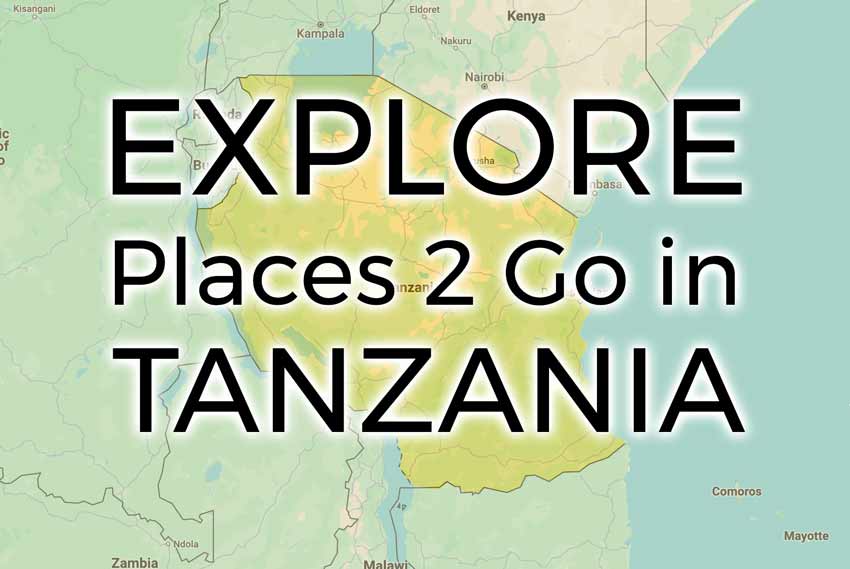Description: This park is known for its elephants. You will see these enormous creatures travel in families, and you will not miss the extraordinary care they take of their young. The elephants tend to travel in packs and in the same paths as they have taken year after year. When they see your vehicle coming closer, they will gather around their young to protect them and lead them on their way. Here you will have the opportunity to simply sit and watch.
Also in this park is the Tarangire River. This river winds through the middle of the park providing nourishment for the animals and great viewing for visitors. Every day large herds of animals and birds gather around this river so you will be sure not to miss anything.
It also boasts many Baobab trees, impressive trees that can live for thousands of years. Animals can be found in the rainy seasons, but the concentration of wildlife tends to be better during the dry seasons.
Location: 2 hours from Arusha Town and almost directly between Arusha and Ngorongoro Crater.
Things 2 Do: Game Drives, Hot Air Balloon, Guided Walks (from select accommodations only) and Night Game Drives (from select accommodations only)
Time: Minimum of 1 night but 2 is better.
Animals: Though cheetahs are rare, you’ll find pretty much all the animals you will see on safari except rhinos. Has more than 550 bird species!
Accommodations
$
A2T Camping (public campsites)
$$
Butman Tarangire Lodge
Kikoti Safari Camp
Burunge Tented Lodge
Tarangire Roika Tented Lodge
Sangaiwe Tented Lodge
Tarangire Osupuko Lodge
Whistling Thorn Camp
$$$
Boundary Hill Lodge
Kirumuru Tarangire Lodge
Maramboi Tented Camp
Tarangire Ndovu Tented Lodge
Nyikani Camp Tarangire
Tarangire River Camp
Tarangire Safari Lodge
Tarangire Sopa Lodge
Tarangire Tortilis Camp
$$$$
Ecoscience Luxury Lodge
Lemala Mpingo Ridge
Little Oliver’s Camp
Naitolia Eco-Lodge
Oliver’s Camp
Sidai Camp
Sanctuary Swala Camp
$$$$$
Tarangire Treetops
Tarangire National Park Safari with Access 2 Tanzania
Have you ever imagined standing in the midst of hundreds of wild elephants as they traverse the plains with their young? Tarangire National Park, one of Tanzania’s premier wildlife destinations, offers this extraordinary experience. Known for its rich biodiversity and dramatic scenery, this park provides an authentic safari adventure for travelers seeking to witness nature at its most vivid and raw.
Exploring Tarangire National Park Tour
Tarangire National Park is located just two hours from Arusha Town, strategically situated between Arusha and the Ngorongoro Crater. Its proximity makes it an ideal destination for both short visits and extended safaris. The park covers an area of 2,850 square kilometers and is distinguished by its dense elephant population, unique Baobab trees, and the life-giving Tarangire River. For travelers booking a Tarangire national park tour with Access 2 Tanzania, it is an opportunity to immerse themselves in a setting where wildlife thrives in its natural rhythm.
Visitors to the park will notice that elephants here follow well-worn paths that they use year after year. Observing them in their natural habitat, especially as they protect their young, is a spectacle of familial bonds and instinctive behavior. These encounters allow guests to pause, reflect, and simply watch the gentle giants move with grace and purpose, creating memories that last a lifetime.
Wildlife and Birding on Tarangire National Park Safari
Tarangire is home to a variety of animals, providing a full safari experience without the need to venture into multiple parks. While cheetahs are rare, most other safari animals, including lions, giraffes, zebras, wildebeests, and leopards, can be seen. The park also boasts more than 550 bird species, making it a haven for bird watchers. The Tarangire River attracts large herds of animals, particularly during the dry season when water sources become scarce elsewhere, ensuring excellent wildlife sightings.
The combination of dry-season congregation and the lush riverine environment creates perfect photographic opportunities for wildlife enthusiasts. Guests can witness natural behaviors, such as elephants gathering to protect their young, or birds feeding along the riverbanks, in a setting that feels untouched and authentic. The variety and abundance of wildlife here make any Tarangire national park safari a truly rewarding experience.
The Role of Tarangire River
The Tarangire River runs through the center of the park, serving as a lifeline for its wildlife. Animals gather here daily, particularly in the dry months, making it one of the most reliable spots to observe wildlife in Tanzania. The river’s presence also supports the rich vegetation and Baobab trees that define the park’s distinctive scenery. These trees, some of which live for thousands of years, add character to the savannah and provide shade for animals and visitors alike.
A safari around the Tarangire River is an immersive way to connect with nature. Observers can watch elephants and other animals interact naturally with their environment, witness predator-prey dynamics, or simply enjoy the peaceful movement of wildlife along the river’s edge. This central feature of the park ensures every tour is packed with action and unique experiences.
Safari Activities in Tarangire National Park Tour
A Tarangire national park tour offers a variety of activities to suit every interest. Traditional game drives allow visitors to explore the park’s vast plains and wooded areas, capturing encounters with elephants, lions, and other iconic wildlife. For those seeking a higher vantage point, hot air balloon safaris provide a bird’s-eye view of the park’s sprawling landscapes, rivers, and animal herds.
Guided walking safaris are available from select accommodations, giving guests a closer connection to the park’s flora and fauna. Night game drives are another option at certain lodges, providing a rare glimpse into the nocturnal behaviors of predators and other wildlife. Whether you are on a day visit or a multi-night safari, these experiences are designed to maximize engagement with Tarangire’s natural wonders.
Best Time to Visit Tarangire National Park Safari
While the park is beautiful year-round, the dry season offers the best opportunity for wildlife viewing. During these months, animals congregate around the Tarangire River, making sightings easier and more predictable. The rainy season brings lush greenery and young wildlife but may make spotting animals more challenging. Most safaris, including those organized by Access 2 Tanzania, recommend a minimum of one night in the park, though two nights allow visitors to explore the park more fully and enjoy a relaxed pace.
Accommodations for Your Tarangire National Park Tour
Tarangire offers a wide range of accommodations to suit every budget. For those seeking a more adventurous experience, A2T Camping provides public campsites in prime locations within the park. Mid-range options include lodges and tented camps such as Butman Tarangire Lodge, Burunge Tented Lodge, and Tarangire Roika Tented Lodge. Luxury accommodations elevate the safari experience, with options like Lemala Mpingo Ridge, Oliver’s Camp, and the exclusive Tarangire Treetops offering unparalleled comfort and service.
Each accommodation type is strategically located to provide easy access to wildlife-rich areas, ensuring guests can enjoy the best of what Tarangire has to offer. The combination of scenic views, quality service, and proximity to key safari routes makes staying in the park both convenient and memorable.
Tips for Travelers
To make the most of a Tarangire national park safari, it’s important to plan ahead. Booking through Access 2 Tanzania ensures access to expert guides, well-planned itineraries, and the best accommodations tailored to your interests. Early morning and late afternoon game drives are ideal for wildlife sightings when animals are most active. Carrying binoculars and a camera is highly recommended, as the park’s scenic points and wildlife encounters provide endless photographic opportunities.
Understanding the behavior of elephants and other wildlife enhances the safari experience. Watching elephants follow their age-old paths and protect their young offers a rare glimpse into their social structure. Observing birds around the Tarangire River or identifying Baobab trees adds depth and appreciation to each tour. The combination of expert guidance and personal observation ensures every safari is educational and exhilarating.
FAQs about Tarangire National Park Safari
Q1: How far is Tarangire National Park from Arusha?
Tarangire National Park is approximately two hours from Arusha Town, making it easily accessible for day trips or extended safari tours with comfortable travel arrangements.
Q2: What animals can I see in Tarangire National Park?
Visitors can expect elephants, lions, giraffes, zebras, wildebeests, and over 550 bird species. Cheetahs are rare, and rhinos are not found in this park.
Q3: What is the best time for a Tarangire safari?
The dry season offers the best wildlife viewing due to animals congregating near the Tarangire River, while the rainy season brings lush scenery but fewer visible animals.
Q4: How long should I stay in Tarangire National Park?
A minimum of one night is recommended, though two nights allows a more relaxed pace, maximizing opportunities for game drives, hot air balloon rides, and other safari activities.
Q5: Are guided walks available in Tarangire?
Yes, guided walking safaris are offered from select accommodations, providing a closer look at flora, fauna, and the park’s ecosystem with expert guidance.
Q6: What types of accommodations are available in Tarangire?
Options range from budget-friendly campsites to mid-range lodges and luxury tented camps, including Tarangire Treetops, Lemala Mpingo Ridge, and Oliver’s Camp for high-end safari experiences.
Q7: Can I do a hot air balloon safari in Tarangire?
Yes, hot air balloon safaris provide an exceptional perspective of the park, offering panoramic views of wildlife, rivers, and vast plains, available through select tour operators.
“Access 2 Tanzania was awesome! Visiting Africa and going on Safari was on my bucket list and A2T fulfilled it completely. My husband likes spontaneity but I insist on long term planning so when my husband told me he wanted to go to Tanzania in just over 3 weeks I laughed. Two days later he came to me with a plan that Casey and he put together. I was dumb-founded. It was not a canned tour planned by A2T for a group. It was a private itinerary planned by my husband and Casey to accommodate exactly what WE wanted to do and where WE wanted to go. We left for Tanzania 3 weeks later! Amazing!
We changed plans many times after the initial plan and Casey was very patient and accommodated us with no resistance. Casey always had answers to our questions and gave us recommendations that we would never had thought of. A2T didn’t just give ‘lip service’ they provided what they said they would and told us what they could not. I questioned this because they offer so many wonderful options and I wondered what we would actually get when we arrived. Another thing I was pleased with is that during our planning Casey did not constantly try to ‘up sell’ us.
‘Wilfred’ was our guide and he was wonderful. He is such a nice, good and fun person. We felt so lucky to have him. That said, we spoke to others from A2T and they also felt the same about their guides so it is clear A2T chooses their guides carefully. (We still feel lucky to have Wilfred throughout our safari!)
I wish I could remember the names of all the others that we met and who helped us from A2T. We didn’t run into one bad seed. It’s been 5 months since we returned from Africa and although the names are not clear in my mind the warm, wonderful and exciting feeling of Africa will never fade.
If you have the opportunity to go to Africa go with Access 2 Tanzania! AMAZING!!”


